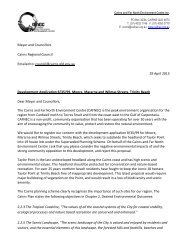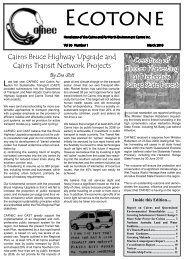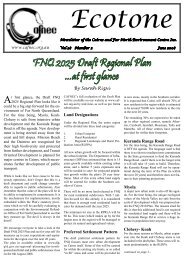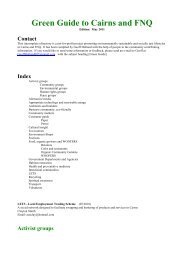Renewable Energy for Far North Queensland: A ... - CAFNEC
Renewable Energy for Far North Queensland: A ... - CAFNEC
Renewable Energy for Far North Queensland: A ... - CAFNEC
You also want an ePaper? Increase the reach of your titles
YUMPU automatically turns print PDFs into web optimized ePapers that Google loves.
Cairns and <strong>Far</strong> <strong>North</strong> Environment Centre May 2011<br />
<strong>Renewable</strong> <strong>Energy</strong> <strong>for</strong> <strong>Far</strong> <strong>North</strong> <strong>Queensland</strong>: a discussion paper<br />
resources probably provide between 5 and 40% of the region’s electricity. Some changes to the<br />
patterns of use of these facilities would be required in order to make the most of these energy<br />
sources. One of the oldest renewable energy generation plants in the region is the Barron River<br />
Gorge Hydro Power Station.<br />
Current peak demand in the FNQ region is approximately 360 MW. Existing renewable<br />
electricity generator contributions in the region are listed in the table below (Table 1).<br />
Table 1 – Summary of <strong>Renewable</strong> <strong>Energy</strong> Generation in FNQ<br />
Site<br />
<strong>Renewable</strong> Approx. Power Owner<br />
Resource Exported to the<br />
Windy Hill Wind <strong>Far</strong>m Wind 12 MW Transfield Services<br />
Kareeya Hydro Hydro 86.4 MW Stanwell Corporation Ltd<br />
Barron Gorge Hydro Hydro 60 MW Stanwell Corporation Ltd<br />
Koombooloomba Dam Hydro 7.3 MW Stanwell Corporation Ltd<br />
Tinaroo Dam Hydro 1.6 MW Sunwater<br />
Tully Sugar Mill Bagasse 10.0 MW Tully Sugar Ltd<br />
Mossman Sugar Mill Bagasse Small quantity Mossman Central Mill<br />
Company Ltd<br />
Mulgrave Sugar Mill Bagasse 2.3 MW Maryborough Sugar Factory<br />
Ltd<br />
South Johnstone Sugar Mill Bagasse Unknown Bundaberg Sugar<br />
Tableland Sugar Mill Bagasse 3.0 MW Bundaberg Sugar<br />
Photo voltaic grid connected<br />
systems (Roof mounted<br />
solar panels)<br />
Solar 4.4 MW Various private householders<br />
and businesses<br />
Total<br />
187 MW<br />
Note: The in<strong>for</strong>mation included in Table 1 has been obtained from various published and<br />
unpublished sources as a result of the many different organisations involved in generating<br />
electricity. A number of the published sources used refer to the total generating capacity of the<br />
asset. Due to the intermittent nature of these renewable energy sources this study has been<br />
unable to confirm the actual energy generated by these plants on an annual basis. In addition,<br />
there are also a number of bagasse power plants in the region but these are co-located with<br />
sugar mills that produce renewable energy but export very little power back to the grid as the<br />
electricity is utilized by the sugar mill. Further work is required to confirm the total amount of<br />
renewable energy actually produced in the region.<br />
4







